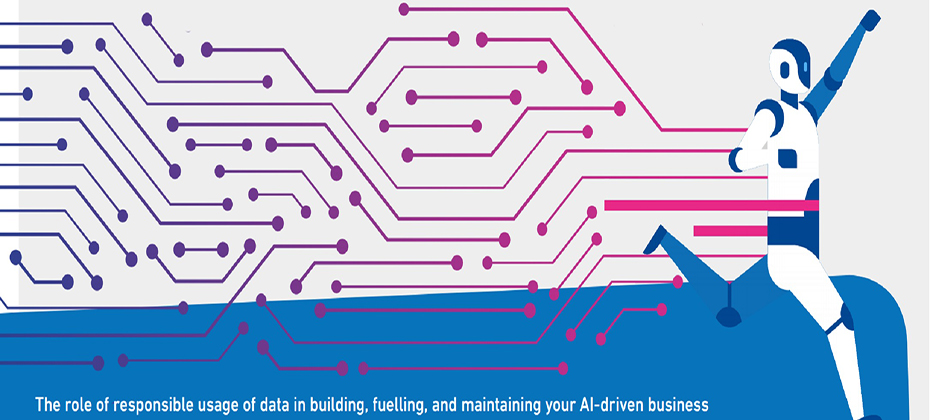Lorem Ipsumis simply dummy text of the printing and typesetting industry. Lorem Ipsum has been the industry’s standard dummy text ever since the 1500s, when an unknown printer took a galley of type and scrambled it to make a type specimen book. It has survived not only five centuries, but also the leap into electronic typesetting, remaining essentially unchanged
Author One

Technology revolutionizes the way businesses operate, but implementing change within a company is often challenging and company-wide support is vital to successfully undergoing a transformation. At Experian, we’re using technology and innovation to modernize an industry, and satisfy the real-time data demands of consumers and businesses. The success of this transformation is one of the reasons why we’re proud that our Global CIO, Barry Libenson, has been named the CIO of the Year. The 2019 Dive Awards recognize the industry’s top disruptors and innovators. These executives, companies, trends, and breakthroughs are transforming the industry. Winners were chosen by the editors of CIO Dive based on thorough and independent research, reporting, and analysis. Other award winners include Google Cloud and VMware. In 2015, Experian began the daunting task of moving from a traditional computing architecture to the cloud. Specifically, we put in motion a cloud strategy centered on flexibility and the ability to operate in any cloud. Such transformations often start by centralizing data and implementing new processes that minimize overhead and speed time to market, like cloud and mobile computing. This is a monumental job with our massive digital infrastructure and significant global reach, but it enables us to provide customers with real-time access to data. To do this we pioneered the use of Hadoop to store massive quantities of data for consumer credit scoring. Today, we maintain Ascend, a platform of 250 million redacted consumer records that enables our clients do real time queries on consumer credit data rather than batch processing. This has worked to digitally transform Experian from a traditional credit bureau to a technology and software provider. For us to further evolve we began working on APIs for internal use rather than going straight to customer-facing features. Today, we use APIs to help our clients and consumers access and make use of key data insights. For example, Experian Boost, which has helped millions of people raise their credit scores, is a result of information being accessed through API calls. As a result of our digital transformation, our API hub is processing more than 100 million transactions a month and Ascend is now one of our most successful cloud computing architectures. This all represents business opportunities that wouldn’t have been possible with a traditional digital infrastructure. Success for the technology team at Experian is found in the financial performance of the company. "What I tell my team is the biggest sign of us being successful is praise," said Libenson. "When the businesses at Experian tell us we're helping them or we're doing the right things, that's the best measurement I can think of, in terms of success." As one of the world’s most innovative companies, Experian’s business continues to evolve to deliver faster, better services for our clients and consumers. "The people and organizations that win the Dive Awards are trailblazers and leaders in their markets," said Davide Savenije, editor-in-chief of CIO Dive’s publisher Industry Dive. "Their achievements in 2019 are shaping the future of where the latest strategies and trends are going." While industry accolades like CIO of the Year are important, the truth is that any transformation isn't an endpoint, but a journey. To succeed, we are in it for the long haul to use technology to help deliver results for our clients. Read the full article on CIODive to learn more about Experian’s digital transformation.

We’re delighted to have been named as one of Britain’s ‘Most Admired Companies’ (BMAC) in Management Today’s annual survey, coming 21st in a list of nearly 250 leading firms from a variety of sectors, and taking third place in the ‘Business Support Services’ sector. Our 17,000 colleagues around the world work hard every day to service and power opportunities for our customers and this award is testament to the commitment they bring to our business every day. The hard work doesn’t stop here. We continue to strive for the highest standards across our global organisation, and we remain committed to delivering the very best services that can empower millions of people to stay in control of their finances, and help businesses meet the needs of their customers. For further information on BMAC, the winners and the methodology, please see: https://www.managementtoday.co.uk/bmac

In today's fast-paced markets, businesses of all sizes strive for an edge over competition, especially when it comes to wining over consumers' hearts and minds. Many find that competitive advantage in the way they apply artificial intelligence to improve their customer decision-making for high business performance. Data strategies for high-performance decisioning In today's fast-paced markets, businesses of all sizes strive for an edge over competition, especially when it comes to wining over consumers' hearts and minds. Many find that competitive advantage in the way they apply artificial intelligence to improve their customer decision-making for high business performance.In fact, recent research we commissioned from Forrester Consulting shows that this. The ability to make meaningful decisions that match your customer's context at a given point in time requires a solid understanding of their needs and goals. Having access to relevant data is essential to consistently deliver experiences that matter. Timing and availability of data is equally important to improving your customer-level decision-making; to make those sought-after better, contextual decisions, you need to have the pertinent data available at the right place and time to meet that given consumer's moment of need. For example, in an operational environment, this may translate into accessing the right type, amount and quality of data in real time, so you are able to respond how and when your customer expects. The role of responsible usage of data in building, fuelling, and maintaining your AI-driven business The energy needs of athletes exceed those of the average person. Similarly, in the AI world, data (nutrient) needs for high-performance require consistent markers over a long period of time. Data scientists looking after credit and fraud risk would use the same variables or 'nutrients' that have been traditionally used for conventional scorecard developments to fuel machine learning methods to build predictive models. These are 'proteins' such as application data, any behavioural data your business has on existing customers, credit bureau data, segmentation data, available public information or transaction data. Some trended economic data can be used as input for developing credit risk methods and governance to fit leading financial reporting standards and frameworks (think of IFRS 9 or Basel, for example). Similarly, to assess affordability, you will need to feed your algorithms with disposable income over your customers' lifetime plus data about how they use it. Financial data about customers' savings, and investments allows for more accurate risk management while property related info derived from rental data is useful for extending personalised credit offers. Meanwhile, more and more businesses are using speech and text data obtained through voice recognition to improve the collection process. In fact, recent research we commissioned from Forrester Consulting shows that this 'race for the customer' comes down to who knows them best. The ability to make meaningful decisions that match your customer's context at a given point in time requires a solid understanding of their needs and goals. Having access to relevant data is essential to consistently deliver experiences that matter. Timing and availability of data is equally important to improving your customer-level decision-making; to make those sought-after better, contextual decisions, you need to have the pertinent data available at the right place and time to meet that given consumer's moment of need. For example, in an operational environment, this may translate into accessing the right type, amount and quality of data in real time, so you are able to respond how and when your customer expects. The role of responsible usage of data in building, fuelling, and maintaining your AI-driven business The energy needs of athletes exceed those of the average person. Similarly, in the AI world, data (nutrient) needs for high-performance require consistent markers over a long period of time. Data scientists looking after credit and fraud risk would use the same variables or 'nutrients' that have been traditionally used for conventional scorecard developments to fuel machine learning methods to build predictive models. These are 'proteins' such as application data, any behavioural data your business has on existing customers, credit bureau data, segmentation data, available public information or transaction data. Some trended economic data can be used as input for developing credit risk methods and governance to fit leading financial reporting standards and frameworks (think of IFRS 9 or Basel, for example). Similarly, to assess affordability, you will need to feed your algorithms with disposable income over your customers' lifetime plus data about how they use it. Financial data about customers' savings, and investments allows for more accurate risk management while property related info derived from rental data is useful for extending personalised credit offers. Meanwhile, more and more businesses are using speech and text data obtained through voice recognition to improve the collection process.

To stay ahead of the competition and on the path of sustained growth, you need clear line of sight to both risks and opportunities through the customer lifecycle. Gaining better insights on customers is critical to achieving that, so you can make all the right decisions, big and small, about your customers and business clients. Based on the conversations we have with our clients, we have noticed that most executives are paying a lot of attention to measuring customer experience and reducing friction across digital touch-points through the lifecycle. For customer acquisition, for example, businesses like yours look at time spent on each micro-step (e.g. data field), dropout rates at each of those steps, and do A/B testing at a very granular level. The idea is to understand all points of friction including points of confusion, frustration, etc., so you can learn from those and improve the experience. But this is not an easy task. The various challenges involved are making sense of the vast quantities of data and the immaturity of that data as well as the construct of that data. Given the fast pace at which data analytics change and evolve, our recommendation is that you invest in tools that are data and/or analytics agnostic. Thinking ahead: leveraging data analytics and cloud-based decisioning platforms to design the right customer treatment There is a largely untapped opportunity to leverage data, analytics, optimisation and decision management solutions – such as cloud-based decisioning platforms – to design the right customer treatment and identify the next best action for that customer. Selecting the appropriate timing, medium, and channel for those actions lead to greater consistency and contribute to having more relevant communications with your customers. The more relevant you are, the more precise you are with the offers and the treatments leading to improved response rates, greater connectivity and interaction with the customer. This results in memorable experiences that enhance loyalty and drive profitability.

This blog is written by Lisa Fretwell, Managing Director of Data Services at Experian. It’s no secret that women are hugely under-represented in careers relating to science, technology, engineering and mathematics (STEM). In fact, research suggests that only 13% of the overall UK workforce are women in STEM and, as a consequence, we find ourselves with fewer female role models to inspire confidence and ambition in the next generation. Positive female role models are fundamental if we are to transform some of the preconceptions that girls have about a career in STEM. And part of encouraging new generations into our industry means recognising and celebrating the achievements of those women blazing a trail here and now. That’s why we are delighted to be sponsors of today’s Women in Data (UK) conference for the third successive year. This unique event helps inspire, educate and support women across the data industry. It’s a privilege to be part of the Women in Data community, to get to know more amazing women in our industry and to share their incredible stories. One of the highlights of the event is the annual ’20 Women in Data and Technology’ recognition, celebrating incredible role models who are motivating others to pursue their own career ambitions in the industry. We were particularly thrilled to learn that our very own Louise Maynard-Atem, has been included in this year’s highly prestigious list. Congratulations to Louise on a truly phenomenal and well-deserved achievement. Experian’s goal is to have a workforce that’s as rich in diversity as the people who use our services. That’s one of the many reasons we’re so excited by WiD’s mission. Together we hope to empower and encourage more women into the data industry, supporting the next generation of data scientists who can help shape the future.
In this article…
First Heading
Lorem Ipsumis simply dummy text of the printing and typesetting industry. Lorem Ipsum has been the industry’s standard dummy text ever since the 1500s, when an unknown printer took a galley of type and scrambled it to make a type specimen book. It has survived not only five centuries, but also the leap into electronic typesetting, remaining essentially unchanged
It was popularised in the 1960s with the release of Letraset sheets containing Lorem Ipsum passages, and more recently with desktop publishing software like Aldus PageMaker including versions of Lorem Ipsum.
Why do we use it?
It is a long established fact that a reader will be distracted by the readable content of a page when looking at its layout. The point of using Lorem Ipsum is that it has a more-or-less normal distribution of letters, as opposed to using ‘Content here, content here’, making it look like readable English. Many desktop publishing packages and web page editors now use Lorem Ipsum as their default model text, and a search for ‘lorem ipsum’ will uncover many web sites still in their infancy. Various versions have evolved over the years, sometimes by accident, sometimes on purpose (injected humour and the like).
It was popularised in the 1960s with the release of Letraset sheets containing Lorem Ipsum passages, and more recently with desktop publishing software like Aldus PageMaker including versions of Lorem Ipsum.
Why do we use it?
It is a long established fact that a reader will be distracted by the readable content of a page when looking at its layout. The point of using Lorem Ipsum is that it has a more-or-less normal distribution of letters, as opposed to using ‘Content here, content here’, making it look like readable English. Many desktop publishing packages and web page editors now use Lorem Ipsum as their default model text, and a search for ‘lorem ipsum’ will uncover many web sites still in their infancy. Various versions have evolved over the years, sometimes by accident, sometimes on purpose (injected humour and the like).
Second Heading
It was popularised in the 1960s with the release of Letraset sheets containing Lorem Ipsum passages, and more recently with desktop publishing software like Aldus PageMaker including versions of Lorem Ipsum.

Where can I get some?
There are many variations of passages of Lorem Ipsum available, but the majority have suffered alteration in some form, by injected humour, or randomised words which don’t look even slightly believable. If you are going to use a passage of Lorem Ipsum, you need to be sure there isn’t anything embarrassing hidden in the middle of text. All the Lorem Ipsum generators on the Internet tend to repeat predefined chunks as necessary, making this the first true generator on the Internet. It uses a dictionary of over 200 Latin words, combined with a handful of model sentence structures, to generate Lorem Ipsum which looks reasonable.
There are many variations of passages of Lorem Ipsum available, but the majority have suffered alteration in some form, by injected humour, or randomised words which don’t look even slightly believable. If you are going to use a passage of Lorem Ipsum, you need to be sure there isn’t anything embarrassing hidden in the middle of text. All the Lorem Ipsum generators on the Internet tend to repeat predefined chunks as necessary, making this the first true generator on the Internet. It uses a dictionary of over 200 Latin words, combined with a handful of model sentence structures, to generate Lorem Ipsum which looks reasonable. The generated Lorem Ipsum is therefore always free from repetition, injected humour, or non-characteristic words etc.
Author test
Buttons margin test
